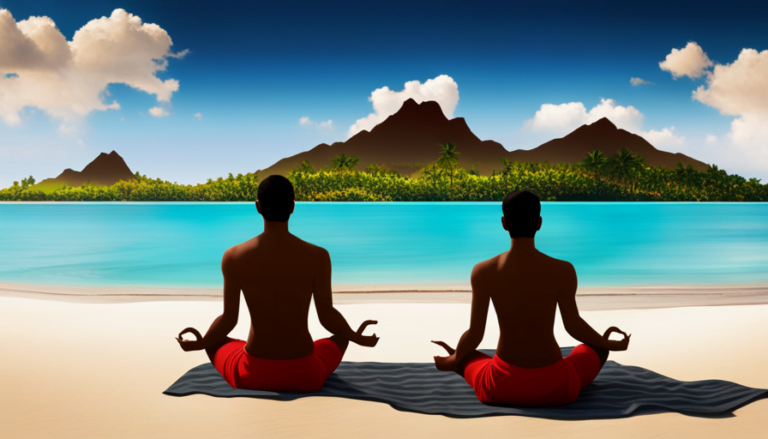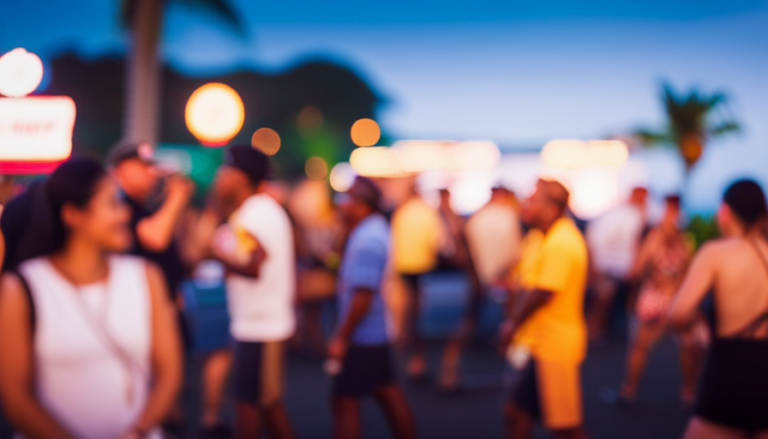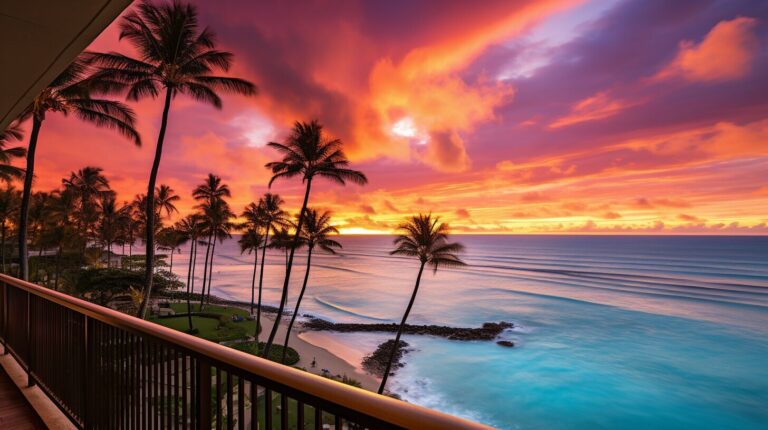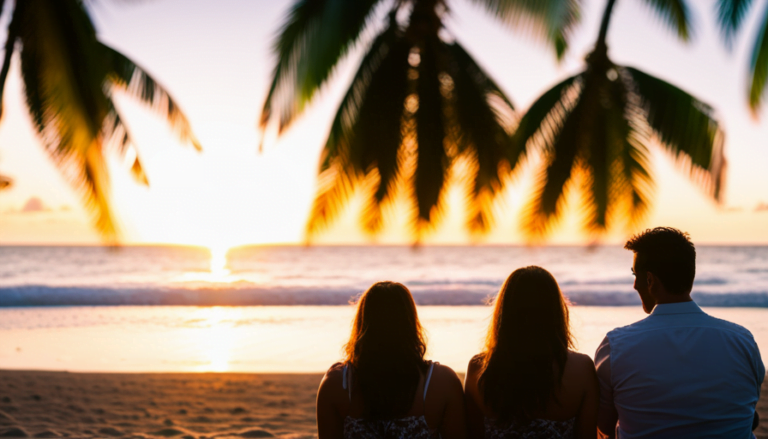Discover Oahu’s Weather Wonderland 🌺
Are you planning a trip to Oahu? If so, it’s important to understand the weather patterns of this Hawaiian island. Oahu’s climate is considered tropical, with warm temperatures year-round. However, there are variations in weather depending on the time of year and location on the island.
In general, the weather on Oahu is influenced by two main factors: trade winds and ocean currents. The trade winds bring cool breezes and provide relief from the heat, while the ocean currents regulate the temperature and humidity levels. Understanding these factors can help you plan your trip and pack accordingly.
In this article, we will provide an overview of Oahu’s weather patterns, the best time to visit, packing tips, weather-related activities, safety considerations, and resources for weather information.
Key Takeaways
- Oahu has a tropical climate with two distinct seasons: dry season (May – Oct) and wet season (Nov – Apr)
- The weather varies depending on the location, with the Eastern side being cooler, more humid, and experiencing more rainfall, while the Western side is warmer, drier, and gets more sunshine.
- The best time to visit Oahu is during mid-Dec to mid-April, which is the peak tourism season, and during mid-Apr to early June, Sep to mid-Dec, which is the shoulder season.
- Visitors to Oahu should pack essential items like sunscreen, sunglasses, a hat, lightweight, breathable clothing, and comfortable walking shoes. They can engage in exciting water activities like snorkeling, diving, and surfing, go on hiking trails, or explore indoor attractions like virtual experiences, traditional Hawaiian luaus, and historical sites. Visitors should prioritize their physical safety and safety from potential hazards like flash floods and high surf.
Overview of Oahu’s Weather Patterns
Despite its small size, Oahu has a diverse range of weather patterns due to its varying climate zones. The island has a tropical climate with two distinct seasons: the dry season from May to October and the wet season from November to April.
However, the weather can vary greatly depending on which part of the island you’re in. The eastern side of Oahu, where the Ko’olau Mountains are located, receives more rainfall and is generally cooler and more humid than the western side of the island. This is due to the impact of trade winds that blow from the northeast, bringing moisture and cooler temperatures to the eastern side of the island.
On the other hand, the western side of Oahu, where Waikiki and the North Shore are located, is generally warmer and drier, with less rainfall and more sunshine. The trade winds also have an impact on this side of the island, as they blow offshore and create ideal conditions for water sports like surfing.
Now, let’s talk about the best time to visit Oahu.
Best Time to Visit Oahu
If you’re planning a trip to paradise, the best time to visit Oahu is when the sun is shining and the ocean is warm.
Oahu’s peak tourism season runs from mid-December to mid-April, when the temperatures range from the mid-70s to mid-80s Fahrenheit. However, if you’re looking for a more affordable and less crowded time to visit, consider coming during the shoulder season, which runs from mid-April to early June and from September to mid-December.
During these times, the temperatures are still warm, ranging from the mid-60s to mid-80s Fahrenheit, and the weather is generally dry with fewer crowds.
No matter when you decide to visit, it’s important to pack accordingly. From June to November, it’s hurricane season, so be sure to pack rain gear and plan accordingly for any potential weather disruptions.
Additionally, since the weather can be unpredictable, it’s important to bring layers, such as a light jacket or sweater, to ensure you’re comfortable no matter what the temperature is like.
With Oahu’s beautiful weather and diverse activities, you’re sure to have an unforgettable trip.
Packing Tips for Oahu
Get ready for your trip to paradise with these essential packing tips to ensure you have everything you need for a comfortable and memorable stay.
As you prepare for your trip to Oahu, remember to pack beach essentials such as sunscreen, sunglasses, and a hat to protect yourself from the sun’s harmful rays. Additionally, packing a beach bag with a towel, beach mat, and a reusable water bottle will come in handy during your beach excursions.
When it comes to fashion tips, keep in mind that Oahu is a relaxed and casual destination. Pack lightweight and breathable clothing such as shorts, t-shirts, and sundresses to stay comfortable in the island’s warm and humid climate. Don’t forget to pack a pair of comfortable walking shoes for exploring the island’s natural beauty.
With these packing tips, you’ll be ready to enjoy all that Oahu has to offer. As you embark on your adventure, keep in mind the various weather-related activities available to you on the island.
Weather-Related Activities
When it comes to weather-related activities in Oahu, you have plenty of options to choose from. If you’re a water lover, you can try out some surfing, paddleboarding, or snorkeling.
For those who enjoy hiking and outdoor adventures, there are plenty of trails to explore, including the famous Diamond Head.
And if the weather takes a turn for the worse, don’t worry – there are plenty of indoor attractions to keep you entertained, such as the Bishop Museum or the USS Arizona Memorial.
Water Activities
You’ll love the crystal clear waters around Oahu for snorkeling and diving. With numerous snorkeling spots available, you can explore the underwater world and see colorful fishes, sea turtles, and coral reefs. Some popular snorkeling spots include Hanauma Bay, Sharks Cove, and Electric Beach. These spots offer different experiences, such as calm waters for beginners or more adventurous areas for advanced snorkelers.
If you’re interested in diving, you can also take lessons and explore the deeper areas around the island. There are many diving centers that offer courses for beginners, as well as guided dives for experienced divers.
If you’re not a fan of snorkeling or diving, you can still enjoy the water by taking surfing lessons. Oahu is known for its big waves and is a popular destination for surfers, both beginners, and professionals. Some of the best surfing spots include Waikiki Beach, North Shore, and Makaha. You can take lessons from experienced surfers and learn how to ride the waves like a pro.
After a day of water activities, you can transition into hiking and outdoor adventures, where you can explore the beautiful landscapes of Oahu.
Hiking and Outdoor Adventures
To truly immerse yourself in the stunning natural beauty of Oahu, take a hike through lush rainforests, breathtaking mountains, and picturesque waterfalls. The island has a wide variety of trails to suit all levels of hikers, from easy strolls to challenging climbs.
Some of the most popular trails include the Makapu’u Point Lighthouse Trail, the Diamond Head Summit Trail, and the Manoa Falls Trail. As you hike, keep an eye out for the island’s unique wildlife. Oahu is home to a variety of bird species, including the endangered Hawaiian goose and the native ‘elepaio.
You may also spot the colorful ‘apapane bird, which is known for its distinctive red plumage. In addition to birds, you may also encounter native insects, such as the Hawaiian damselfly, or even larger animals like wild pigs or mongoose. Be sure to follow all posted trail rules and guidelines to ensure a safe and enjoyable hike.
Moving on to indoor attractions, there are plenty of options for those who want to take a break from the sun or rainy weather.
Indoor Attractions
If you’re looking for a break from the outdoors, there are plenty of indoor attractions on the island of Oahu. One popular option is to check out some of the virtual experiences available.
Many museums and cultural centers have adapted to the current situation by offering online exhibits and tours. For example, the Bishop Museum has a virtual tour of its Hawaiian Hall, which showcases the history, culture, and traditions of the Hawaiian people. The Honolulu Museum of Art also has a virtual tour available, which features over 60,000 works of art from around the world.
In addition to virtual experiences, there are plenty of cultural activities to explore indoors on Oahu. You can attend a traditional Hawaiian luau to learn about the history and customs of the islands, or visit the Polynesian Cultural Center to see performances and demonstrations from different cultures throughout the Pacific.
Other options include visiting historical sites like Iolani Palace or the USS Arizona Memorial, or checking out the local shops and markets to sample Hawaiian cuisine and purchase souvenirs. Just be sure to follow safety considerations to protect yourself and those around you.
Safety Considerations
When the sun beats down on you like a fiery hammer, it’s crucial to prioritize safety considerations in Oahu’s hot weather. Emergency preparedness is key, as weather-related accidents can happen unexpectedly. Be sure to bring plenty of water and sunscreen, and consider packing a first-aid kit. It’s also important to know the signs of heat exhaustion, such as fatigue, dizziness, and headaches, and to seek medical attention if symptoms worsen.
In addition to physical safety, it’s also important to be aware of other potential hazards in Oahu’s weather. Flash floods and high surf can occur suddenly, so be sure to check weather reports and warnings before heading out. Don’t take unnecessary risks, and always follow any instructions or warnings from local authorities.
By prioritizing safety considerations in Oahu’s weather, you can enjoy all that the island has to offer to the fullest.
As you plan your activities, it’s helpful to have resources for Oahu weather information on hand. By staying up-to-date on weather patterns, you can make informed decisions about when and where to go. Whether you check online resources or download a weather app, make sure to have reliable information easily accessible.
With a little preparation, you can stay safe and enjoy the beautiful weather on Oahu.
Resources for Oahu Weather Information
Stay informed and always be prepared for whatever Mother Nature throws your way with these helpful resources for staying up-to-date on the island’s ever-changing conditions. Oahu weather can be unpredictable, but with live webcams and local weather apps, you can stay ahead of the game and plan your day accordingly.
Live webcams provide a real-time view of current weather conditions across the island. From popular tourist spots to remote locations, you can find a webcam that suits your needs. Local weather apps also offer up-to-date information on current weather conditions, including temperature, humidity, wind speed, and more. By using these resources, you can avoid being caught off guard by sudden rain or unexpected weather changes and enjoy your time on Oahu to the fullest.
Frequently Asked Questions
What is the average temperature of the ocean water surrounding Oahu?
The average temperature of ocean water varies seasonally and is influenced by factors such as sunlight and wind. It is typically between 75-80 degrees Fahrenheit in tropical regions, but can fluctuate depending on location and time of year.
Are there any areas on Oahu that are more prone to extreme weather conditions?
Certain areas on Oahu are more prone to extreme weather conditions due to climate patterns and microclimates. These localized weather conditions can vary greatly from the island’s overall weather patterns, and can impact various regions differently.
What is the likelihood of experiencing a hurricane while visiting Oahu?
Beware of hurricanes when visiting Oahu. The island has experienced several hurricanes in the past, with a frequency of one every ten years. Weather patterns suggest that it’s best to avoid visiting during hurricane season.
Are there any unique weather phenomena that occur on Oahu?
On Oahu, you can experience unique weather phenomena due to microclimates and climate change. These include localized rain showers, strong trade winds, and even snow on the island’s highest peaks.
How does the weather on Oahu compare to other Hawaiian islands?
As the old saying goes, u0022comparing apples to oranges.u0022The overall climate and humidity levels on Oahu differ from other Hawaiian islands. Objective data shows variations in temperature and rainfall between islands.







